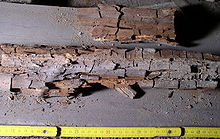


A wood-decay or xylophagous fungus is any species of fungus that digests moist wood, causing it to rot. Some species of wood-decay fungi attack dead wood, such as brown rot, and some, such as Armillaria (honey fungus), are parasitic and colonize living trees. Excessive moisture above the fibre saturation point in wood is required for fungal colonization and proliferation.[1] In nature, this process causes the breakdown of complex molecules and leads to the return of nutrients to the soil.[2] Wood-decay fungi consume wood in various ways; for example, some attack the carbohydrates in wood, and some others decay lignin. The rate of decay of wooden materials in various climates can be estimated by empirical models.[3]
Wood-decay fungi can be classified according to the type of decay that they cause. The best-known types are brown rot, soft rot, and white rot.[4][5] Each produce different enzymes, can degrade different plant materials, and can colonise different environmental niches.[6] Brown rot and soft rot both digest a tree's cellulose and hemicellulose but not its lignin; white rot digests lignin as well. The residual products of decomposition from fungal action have variable pH, solubility and redox potentials. Over time this residue becomes incorporated in the soil and sediment so can have a noticeable effect on the environment of that area.[6]
Wood decay fungi are considered key species in the forest ecosystems [7] because the process of decomposing dead wood creates new habitats for other species, helps in the nutrient recycling, participate in the energy transportation and transformation and provides food to other species.[8] They are also used as indicator species for conservation projects.
Wood decay fungi are dependent on wood. Due to forestry, cutting trees and removal of decaying wood, many species are classified as threatened.[9][10]
- ^ Harris, Samuel Y. (2001). Building Pathology: Deterioration, Diagnostics, and Intervention. John Wiley & Sons. p. 106. ISBN 978-0-471-33172-8.
- ^ "Wood Decay in Living and Dead Trees: A Pictorial Overview" (PDF). Archived from the original (PDF) on 2022-01-24. Retrieved 2018-02-28.
- ^ Viitanen, T. et al. (2010). Towards modelling of decay risk of wooden materials. European Journal of Wood and Wood Products 68:303-313.
- ^ Cite error: The named reference
deacon-wwwwas invoked but never defined (see the help page). - ^ Cite error: The named reference
minnesotawas invoked but never defined (see the help page). - ^ a b Vane, C. H., et al. (2005). "Decay of cultivated apricot wood (Prunus armeniaca) by the ascomycete Hypocrea sulphurea, using solid state 13C NMR and off-line TMAH thermochemolysis with GC–MS." International Biodeterioration & Biodegradation 55(3): 175-185.
- ^ Olsson, Jörgen (2008). Colonization Patterns of Wood-inhabiting Fungi in Boreal Forest (PhD thesis). Umeå University.
- ^ Shingo Miyauchi, Hayat Hage, Elodie Drula, Laurence Lesage-Meessen, Jean-Guy Berrin, David Navarro, Anne Favel, Delphine Chaduli, Sacha Grisel, Mireille Haon, François Piumi, Anthony Levasseur, Anne Lomascolo, Steven Ahrendt, Kerrie Barry, Kurt M LaButti, Didier Chevret, Chris Daum, Jérôme Mariette, Christophe Klopp, Daniel Cullen, Ronald P de Vries, Allen C Gathman, Matthieu Hainaut, Bernard Henrissat, Kristiina S Hildén, Ursula Kües, Walt Lilly, Anna Lipzen, Miia R Mäkelä, Angel T Martinez, Mélanie Morel-Rouhier, Emmanuelle Morin, Jasmyn Pangilinan, Arthur F J Ram, Han A B Wösten, Francisco J Ruiz-Dueñas, Robert Riley, Eric Record, Igor V Grigoriev, Marie-Noëlle Rosso (2020). "Conserved white-rot enzymatic mechanism for wood decay in the Basidiomycota genus Pycnoporus". DNA Research. 27 (2). doi:10.1093/dnares/dsaa011. PMC 7406137. PMID 32531032.
{{cite journal}}: CS1 maint: multiple names: authors list (link) - ^ Jenna, Purhonen; Nerea, Abrego; Atte, Komonen; Seppo, Huhtinen; Heikki, Kotiranta; Thomas, Læssøe; Panu, Halme (2021-07-16). "Wood-inhabiting fungal responses to forest naturalness vary among morpho-groups". Scientific Reports. 11 (1): 14585. Bibcode:2021NatSR..1114585J. doi:10.1038/s41598-021-93900-7. hdl:10138/332607. ISSN 2045-2322. PMC 8285386. PMID 34272417.
- ^ Schilling, Marion; Farine, Sibylle; Péros, Jean-Pierre; Bertsch, Christophe; Gelhaye, Eric (2021-01-01), Morel-Rouhier, Mélanie; Sormani, Rodnay (eds.), "Chapter Six - Wood degradation in grapevine diseases", Advances in Botanical Research, Wood Degradation and Ligninolytic Fungi, vol. 99, Academic Press, pp. 175–207, doi:10.1016/bs.abr.2021.05.007, S2CID 238920143, retrieved 2023-03-29